Cervical osteochondrosis is a disease that is difficult to diagnose when the patient’s initial treatment to the doctor due to a large number of signs and a slowed course of the disease.
Development and manifestation of pathology
Osteochondrosis of the cervical spine is found in people who lead a sedentary lifestyle and have a sedentary work.
Signs
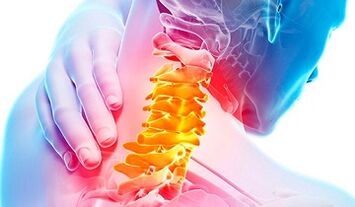
Signs of osteochondrosis of the cervical vertebrae are not only pain in the cervical region and the upper shoulder zone, but also headaches, chest pain.
Several syndromes are distinguished, each of which is characterized by its own signs.
The rooser syndrome is due to a pinching of the nerve endings in the intervertebral space of the cervical spaces.Characteristic features:
- pain in the cervical region;
- pain in the forearm and to the hands;
- The sensations of tingling, numbness in the forearm.
The cardial syndrome (or heart syndrome) is due to infringement or irritation of the roots of the nerves of the diaphragm and (or) large chest muscle.In this case, the signs will serve as pain in the heart area, which will be long in time and sharp in case of rotation of the head, sneezing or other movements of the neck (as in the case of angina pectoris).
Vail artery syndrome.Signs of osteochondrosis in this case will be:
- pulsating headaches in the occipital, frontal (above eyebrows) and temporal part, which are constant;
- Disorders of the hearing apparatus, vestibular apparatus, vision (when osteochondrosis of the cervical vertebrae is already in a neglected state) are possible.
Irritive-reflex syndrome.Signs of such a syndrome are:
- pulsating pains in the occipital part of the head;
- pain in the cervical part, passing even lower to the chest or spreading to the side, in the shoulder joint;
- Strengthening pain after sleep, sharp movements of the head (including sneezing, coughing).
Symptoms
Symptoms with developing osteochondrosis depend on which nerve root is damaged.In the cervical region 7 vertebrae, between which there are nerves.Their damage causes pain in the development of osteochondrosis.
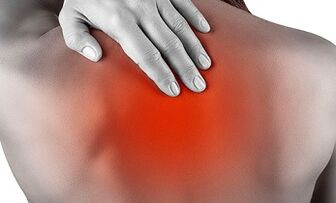
The vertebrae are considered from top to bottom and are indicated by Roman numbers (CI, CII).The nerve endings between them are considered similarly and are designated by Arabic numerals (C1, C2).The letter C denotes a cervical (from lat. The cervical) department.
- In case of damage to the nervous end between the first and second vertebrae (C2), the main symptom will be numbness and loss of sensitivity in the occipital part.Later - pain there.
- Damage to the nerve ending (C3) between the second and third vertebrae, leads to impaired sensitivity in the area, and later leads to impaired sensitivity and impaired language (up to speech impairment).
- Damage to the nervous end between the third and fourth vertebrae (C4).In this case, pain concentrates in the clavicle, pass into the area of the heart, and breathing impairment is possible.But pains are preceded by a feeling of numbness in a collar and shoulders.
- Damage to the nerve root of C5 between the fourth and fifth vertebrae.In case of damage, it responds with impairment of the sensitivity of the limbs, both the upper (to the hands) and the lower ones, as well as pain in the forearm and outer part of the shoulder.
- Damage to the nerve ending in the area of the fifth, sixth and seventh vertebrae (the most common cervical osteochondrosis).Symptoms of pinching of the nerve endings of C6 and C7 are periodic numbness of the fingers and hands, pain in the neck, forearm and below - the shoulder blade, back, up to the lumbar.
- Damage to the nerve C8.The pain is concentrated in the neck and spreads through the forearm to the elbow and on the back to the lower extremities.Pain is preceded by loss of sensitivity in significant areas of the hands (fingers, brushes), legs (fingers, feet), skin.Blood circulation in the limbs is disturbed, which affects the color of the skin of the hands and feet.
Reasons

Cervical osteochondrosis is increasingly found among the young population.The reasons explaining the occurrence of the disease are more often due to the wrong way of life than a hereditary predisposition.
Among the hereditary causes, not only a genetic predisposition to the disease is distinguished, but also the presence of chronic diseases, hereditary abnormalities of the development of the spine.
The list of causes of osteochondrosis of the cervical vertebrae associated with the way of life is very wide.These include:
- Improper nutrition, and, consequently, the excess body weight, a disturbed metabolism in the body, a lack of vitamins and minerals.
- A sedentary lifestyle, which is caused by sitting or uniform work.Unstable physical activity.
- Severe physical activity.This includes professional sports, frequent lifting of weights.
- The curvature of the spine, violation of posture, consequences of spinal injuries, developed flat feet.
- Stress, frequent nervous strain.
Diagnostics
The diagnosis of osteochondrosis should only be made by a doctor.
Visual diagnostics
When contacting a neurologist and an orthopedic doctor, an examination and survey of the patient will initially be conducted.After palpation, assessment of the mobility of the neck and the degree of pain, the patient will be aimed at hardware diagnostics.
Radiography
The method will help to identify changes in the cervical region and determine their degree.For a more accurate diagnosis, it is possible to use functional radiography, when pictures of the cervical spine are taken in various poses, which helps to “capture” changes in the intervertebral space from several sides.
Magnetic resonance tomography
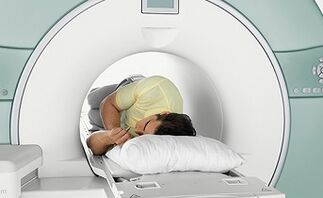
The method using magnetic pulses to obtain a tomogram, on which it is possible to diagnose not only pathologies in the structure of vertebrae and intervertebral cartilage, but also identify the presence of intervertebral hernias, their size and location.
When using MRI in the results of the diagnosis, changes will be visible in the vascular system and nerve endings of the vertebral department.
Computed tomography
This is a detailed analysis of the condition of the vertebrae using a tomograph and computer processing of the result.The method allows not only to identify changes in the vertebrae and intervertebral spaces, but also to analyze the condition of the soft tissues, blood vessels and ligaments.
Differential diagnosis
After sending to one of the diagnostic procedures, the doctor will conduct differential diagnosis - it will exclude the presence of other diseases in the body that have similar symptoms.This will require a blood test, a referral to other medical specialists.
What is dangerous to ignore osteochondrosis?
Cervical osteochondrosis, has periods of remission and exacerbation.Often unhealthy people, without going to the doctor in time and using painkillers, feel relief and forget about the problem until the next exacerbation.But the disease continues to develop and, if you continue to ignore obvious symptoms, can lead to serious complications in the cervical region.
Among the first and therefore, relatively “mild” consequences of the launch of osteochondrosis of the cervical region, protrusion and hernia of the intervertebral discs are distinguished.
In the first case, the intervertebral disc is protruding, its displacement from the normal location between the vertebrae.At the same time, the connecting fibers inside the intervertebral disc (fibrous ring) remain intact and intact.
Propesion in the cervical spine is serious even with size up to 1 mm, while in other parts of the spine these changes are not so dangerous.
After the formation of protrusion, the destruction will affect the fibrous ring - connecting fibers that protect the internal jacket of the pulpo nucleus.Pathological changes in these structures lead to the formation of hernia of the intervertebral disc.The formation and development of hernia is accompanied by increasing pain syndromes and unpredictable consequences.
The more serious consequences of osteochondrosis, if there is no treatment, are vascular disorders: vegetovascular dystonia, hypertension and hypotension.
The formation of hernias of the intervertebral disc leads to a violation of the proper location and functioning of blood vessels, squeezing the arteries that feed the brain.This leads to a violation of oxygen intake into the brain and its normal work, contributes to the formation of blood clots in vessels with a further gap.The result of the development of the disease is a stroke.
First aid
With exacerbation of osteochondrosis, the first question that the patient is faced with: “How will it get rid of pain in the cervical region?”
Medicines containing analgesics, as well as painkillers, will help to remove the pain sensation, and the constraint in movements will help in movements.
When acute pains pass, the next hours and days before going to the doctor can use anti -inflammatory painkillers.During periods of an exacerbation decline, you can use warming ointments, they will help relieve tension in the neck and distract from painful pain.The ointments should be applied with light movements without massage.
If an attack of pain in the cervical spine found you far from the first -aid kit, such means such as an applicator, pepper, mustard, a bag of sand can help.

The applicator should be put on a flat surface, lie on it so that it is under the cervical department, the occipital part of the head and the shoulder joint.A few minutes will have to suffer pain on the skin.Lying on the applicator should be 2-3 times a day for 30-40 minutes.
Pepper patch or mustard, you can use a bag with warm sand, you should apply to the sore spot on the neck, leave for several minutes.Heat will relax the muscles, and distract irritation from pepper or mustard from pain.
Exercises from exercise therapy (physiotherapy exercises), recommended for cervical osteochondrosis, are able to reduce pain, but by a meek period of time.Exercises should be done regularly during periods of remission - this will contribute to the speedy treatment and reduction of the severity and frequency of exacerbations of the disease.
After receiving first aid and removing pain, you need to seek help from doctors as soon as possible.
Treatment
Treatment of osteochondrosis is carried out using different methods.
Traditional medicine
Popular and effective is drug treatment.
Drug treatment
Anesthetic tablets are used during the period of exacerbation of osteochondrosis and are more suitable for an ambulance to the patient.In such cases, analgesics are used.
Treatment is carried out by other drugs - non -steroidal anti -inflammatory drugs (NSAIDs).
Modern medicine uses a new type of drug - chondroprotectors - drugs that restore cartilage tissue.
During the period of exacerbation of the disease, when the pain syndrome can be very pronounced, doctors prescribe injections that not only relieve pain, but have an anti -inflammatory effect.
Blockade of pain syndrome
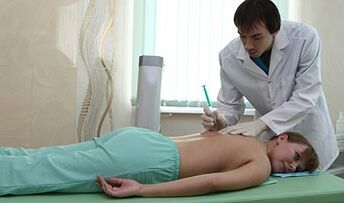
In advanced cases, during the exacerbation of the pain syndrome, it can be resistant to analgesics and even to injections of painkillers.Then the doctor can be performed by the so -called “blockade” - the introduction of an anesthetic drug to a source of pain using an injection.Thus, the painful section of the spine is “disconnected” from the general nervous “composition” and for some time (depending on individual characteristics) the pain from this area does not disturb the patient.
An experienced medical personnel must necessarily carry out the procedure, since an incorrectly completed procedure can lead to complications.The blockade itself has no contraindications except for individual intolerance to drugs and can be done as often as the body requires.
Non -traditional medicine
Osteochondrosis is a disease that is not so easy to treat, so you need to approach this comprehensively.In the treatment of osteochondrosis, acupuncture is used.
The acupuncture is not a method of traditional medicine, but it has established itself in the fight against osteochondrosis in that it allows you to relieve pain and can be used during periods of exacerbation.It should be remembered that it does not bring acupuncture as such, it reduces the symptoms, helps more easily transfer periods of exacerbation of the disease, improves the mobility of the neck and joints, and the processes of restoration and regeneration activated by exposure contribute to the speedy recovery.
Physiotherapy
In addition to drug treatment, doctors recommend that physiotherapy be conducted.
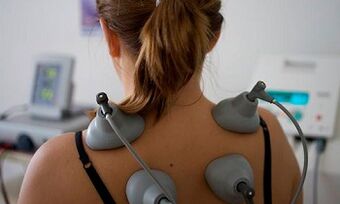
- Electrophoresis.In the case of osteochondrosis, electrophoresis is used with non -steroidal anti -inflammatory and analgesic drugs in order to convey the medicine to the affected area pointwise and in the required volume.Electric current enhances the effect of drugs, and the procedure has the effect in treatment.
- ElectrotherapyUsing weak electric currents and magnetotherapy using a magnetic field.They act on sore areas, relieving pain, improving blood circulation.Helps during periods of remission and triggers the processes of cell regeneration, accelerating the healing process.
Other physiotherapists are aimed at increasing blood circulation of a painful area, decreasing edema and inflammation, pain and general strengthening of the body's immunity during treatment.
Treatment with ointments
The use of ointments for osteochondrosis is not the main method in treatment and is prescribed as an additional measure that contributes to a speedy recovery.The ointments used can be divided into several groups.
- Painkillers and anti -inflammatory.Such ointments include analgesic and steroid anti -inflammatory substances.
- Warming ointments.The main component of such ointments has an irritating effect on the skin, which increases the blood supply to the site.This relieves stress, swelling, reduces pain.
- Chondroprotectorsin the form of ointments.The active substances restore cartilage fabric, and auxiliary substances are relieved of inflammation and pain.
- Massage ointments.Ointments used for massage and self -massage.There are natural anti -inflammatory substances, analgesic substances, a complex of regenerating substances of plant origin.
Massage and self -massage

Massage with osteochondrosis of the cervical spine is necessary during periods of remission of the disease in order not to increase pain during the procedure.Massage is prescribed by a course of ten to fifteen sessions and is carried out no more than once a quarter.Massage for cervical osteochondrosis is used as a procedure that strengthens the effect after treatment and to prevent osteochondrosis.
Massage of the collar zone and acupressure, at the place of distribution of the disease, is done by a specialist.The clear movements of the massage therapist help to knead the muscles of the neck, improve blood circulation, relieve tension, and after the massage course, strengthen the neck muscles, which will preserve the preventive effect for several weeks and even months.
If necessary, you can carry out a light massage yourself.It is necessary to knead and grind the muscles of the neck, the occipital part and shoulder muscles to the back.Simple movements in a convenient position and at any time can be an addition to the treatment and prevention of osteochondrosis of the cervical spine.
Self -massage is recommended for several minutes daily, it has no contraindications, and pain, if accompanied by movements, is easily controlled by the patient on their own.
Proper nutrition
In addition to classical treatment, physiotherapeutic procedures and massage, for the treatment and prevention of osteochondrosis of the cervical spine, proper nutrition with a full range of vitamins and minerals is necessary.

The main ones in this matter are vitamins A and C, strengthening the vessels.Vitamins B6 and B12 improve the metabolism and amino acids in the body, help the nervous system work correctly and without failures.
Complex vitamins are necessary during the period of remission for the general restoration and strengthening of the body.
Traditional medicine
Folk remedies for the treatment of cervical osteochondrosis are divided into those that relieve pain and can be used for exacerbations, and those that are used by courses for several days or even weeks and have a therapeutic effect of long -term action.
Anesthetic potato compress
You will need:
- potato;
- honey-1-2 tbsp.tablespoons for one potato.
Preparation and application:
- Clean raw potatoes, grate.
- In a shallow bowl, mix with honey until smooth.
- Put the resulting mass in a sore spot, cover with polyethylene and fix it with a diaper.Keep a compress for 1-2 hours.
Infusion of radish radish for anesthesia
Alcohol tinctures in folk medicine are used not only for rubbing sore plots for anesthesia, but also for oral administration for a general strengthening effect, and relief.
For the infusion of radish on vodka, you will need:
- Black radish - half a medium size;
- vodka-50-70 ml;
- honey –3-4 tbsp.tablespoons;
- Salt - 2 tbsp.tablespoons.
Preparation and application:
- Peel the radish, grate on a fine grater.
- In a shallow bowl, mix until smooth: grated radish, honey, salt, vodka.
- Rub the cervical department with the mixture with the mixture 2 times a day during the exacerbation.
- Take inward on an empty stomach for 1 teaspoon 2 times a day during an exacerbation.
Ginger-scenting analgesic ointment
You will need:
- Ginger powder - 1 tbsp.spoon;
- garlic-2-3 cloves;
- butter.
Preparation and application:
- Fry ginger powder in a pan in a small amount of butter.
- Peel the garlic, grate on a fine grater or grind with a crush.
- In a shallow bowl, mix fried ginger powder and garlic until smooth.
- The resulting ointment can be rubbed into a sore spot with exacerbations or used as a compress, tied with a diaper for a few minutes until a burning sensation on the skin.
Oil with rubbish for rubbing
Oil rubbing with slight massage for osteochondrosis is used during periods of remission of the disease, and is done with courses 10-15 days with a break.
You will need:
- oregano (grass) - a handful;
- Olive oil (can be sunflower) 300-500 ml.
Preparation and application:
- Sore (grass) shake finely.
- Add oregano to a bottle of oil and leave to infuse in a dark place for at least a day.
- Strain the oil, also squeezing oregano from oil.
- Use the infused oil for rubbing and light massage of the site affected by osteochondrosis 1 time.
Night compress made of horseradish
You will need:
- horseradish leaves-1-3pcs.;
- boiling water.
Preparation and application:
- Dip the leaves of the horseradish for a few seconds in boiling water (soften).
- Apply softened leaves to the place affected by osteochondrosis, tied with a diaper and insulation with a scarf.
- Leave the compress from the leaves of horseradish at night.The feeling of light pinching is quite acceptable.
- The procedure is done during the remission of the disease with a course of 5-7 procedures with a break for 2-3 weeks.
Lemon-shift cocktail
You will need:
- lemon - 1 pc.;
- garlic-1 head (5-6 cloves);
- boiling water.
Preparation and application:
- Peel the lemon from the peel, seeds, grind with a blender or pass through a meat grinder.
- Peel the garlic, grind with a crush or grate on a fine grater.
- Mix lemon and garlic in a jar or a large bottle, pour a mixture of 0.5 liters.boiling water.
- Insist the resulting mixture of at least 12 hours (leave overnight).
- The resulting lemon-cheese cocktail is consumed daily in half a glass on an empty stomach in the morning.
You can store a cocktail in the refrigerator, prepared as needed.The course of taking a cocktail is 1 month.
Strawberry tea
You will need:
- Forest strawberries (fresh or dried) - 1 tbsp.spoon;
- 1 cup boiling water.
Preparation and application:
- Floor -strawed berries pour boiling water like tea.
- Insist at least 10-15 minutes.
- Drink with osteochondrosis of 2-3 cups per day.
Medical physical education
One of the causes of osteochondrosis is hypodynamia - the lack of physical activity against the background of a sedentary lifestyle.Performing only a few simple exercises will help to alleviate the exacerbation of the disease or prevent its appearance.
Exercises "for home and office"
Resistance
- Pressing the palm to the occipital part of the head press on it, making the effort of the neck muscles.With a hand to resist.Keep a voltage of 10 seconds.
- Change the position of the hand, putting it to the forehead and now try to put on the front in front.Also resisted about 10 seconds.
- Change the position of the hand, putting it with a palm to the temple (right hand to the right temple), also resist the pressure of the hand on the head.Keep a voltage of 10 seconds.
- Change the hand and side of the application of the exercise, now to resist the left (left hand to the left temple).Keep a voltage of 10 seconds.
- Change the situation alternately, repeating the exercise up to 5 times for each position of the hand.
Turns of the head standing
- Stand straight, straightening your shoulders.
- Making the heads of the head as much as possible to the right and left alternately.
- Lower your head to the chin to the neck.
- Make the same turns with your head as much as possible to each side, slowly and without tearing the chin from the neck.
- Perform the exercise slowly, repeat turns up to 5 times in each side in each of the position.
Tilts of the head standing
- Rest your shoulders and throw your head back a little.
- Perform tilting his head left and right, trying to reach the shoulders with his ear.
- Do the exercise slowly and repeat up to 5 times in each side.
Exercises performed lying down
Raising the legs
- Lying on your back, stretch your arms and legs freely.
- Put your legs together, pull your knees to your stomach, while pulling your head up, trying to get your eyes with your knees.
- Refraving, lowering your head and straightening your legs and arms again along the body lying.Repeat, slowly 5 times.
Turns of the head lying
- Lying on the stomach, straightening your legs, place your arms along the body.
- Turn your head to the left, trying to get it to the floor with your right ear, then make the turn of the head to the right, also trying to reach the floor now with your left ear.
- Repeat the turns of the head up to 5 times in each direction.
When performing all the exercises, it should be remembered that in the case of the manifestation of pain, you should refuse to perform the exercise and consult a doctor.
Prevention
The prevention of osteochondrosis of the cervical spine is a healthy lifestyle:
- Physical education and sport (moderately).With a tendency to osteochondrosis, swimming will be the best assistant.It strengthens the muscles of the shoulders and neck.
- Balanced diet.Include a large number of products containing calcium, magnesium, vitamins (cottage cheese and dairy products, peas and other legumes, nuts, fish and seafood) in the diet.
- Breaks in sitting work.At every opportunity, we try to knead the muscles of the neck and back.
- Excessive load.Do not wear much and often severity (including bags on one shoulder).
- Orthopedic pillows and mattress.Use them if possible.
- Do not fat.Excess weight accelerates the development of osteochondrosis.Stand on the scales more often.
To control the condition of the cervical region, it is recommended to make diagnostics at least once every 2-3 years: to conduct an MRI or computed tomography.
In addition, an examination by doctors should be held at least 1 time a year: a surgeon and a neuropathologist.Treatment of any disease is easier and faster if you start when the first signs appear.
























